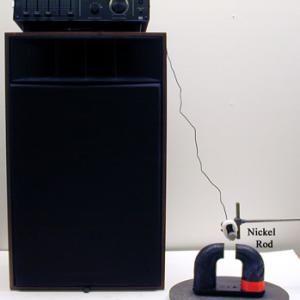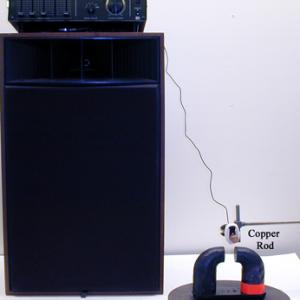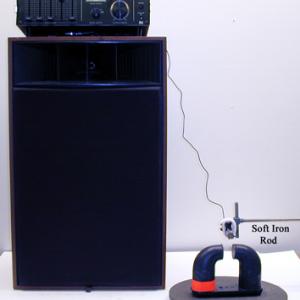College of Liberal Arts & Sciences
5G20.10 - Barkhausen Effect
Insert the desired sample into the bucking coil unit. NOTE: The sample should only protrude into one of the coils, not both. Holding the coil in place, bring one pole of the magnet close to the sample and you should hear a hiss or loud snaps (depending on the sample) as the magnetic domains flip in the sample. Reverse the magnet so the other pole is near the sample and you should again hear the domains flip. There are iron, nickel, and copper samples that can be used with the bucking coils. No sound will be heard with the copper sample.
The nickel rod sample with the phone pickup coil can be subtituted for the bucking coil unit and used in the same manner with the 12 Volt DC system if desired.
I prefer to use the Radio Shack 40 Watt amplifier for this demo as I can easily control most of the hum from the pickup coils by using the three tone control frequency knobs. You should also quickly determine that most of the hum you hear is above the 100 Hz frequency. You could also use the pre-amp and amplifier on this demo that both run off of 12 volt DC to reduce the 60 cycle hum that can mask the sound of the domain flips. Even then, you will still hear some hum due to the location of the lecture rooms and their proximity to high voltage power lines running into the machine room nearby. However, this hum can be greatly reduced by holding the bucking coil unit horizontally in your hand or on the table and turning it until you find the orientation giving the least amount of hum. So, in the final analysis, whether you use the Radio Shack amplifier or the 12 volt DC amplifier unit will depend on the lecture room you are using and its proximity to the high voltage lines coming into the building.
NOTE: The 80 watt Radio Shack amplifier works best with the version of the demonstration that uses the small telephone pickup coil. Place the magnet in the middle of the lazy Susan and place the nickel, copper, or iron rod in a clamp positioned above the center of the magnet. Strap the Radio Shack pickup onto the rod with the Velcro strip, and turn up the amplifier quite far. The nickel rod should produce very loud pops when the magnet is turned beneath it. This is due to the magnetic domain flipping in the nickel. Replace the nickel rod with the copper rod and repeat the experiment. With the copper rod you should hear no loud popping at all. With the soft iron core you will probably not hear any loud pops but you will hear a noticeable hiss.
- James Lincoln, "The Barkhausen Effect Revisited Using LEDs", TPT, Vol. 58, #2, Feb. 2020, p. 140.
- Yaakov Kraftmakher, "Demonstration of the Barkhausen Effect", AJP, Vol. 73, #4, Apr. 2005, p. 367.
- William Lonc, "A Simple Demonstration of the Barkhausen Effect", AJP, Vol. 60, #9, Sept. 1992, p. 860.
- Sung Chang, "Spontaneous Fluctuations in Ferromagnetic Film", Physics Today, Vol. 67, #12, Dec. 2014, p. 22.
- H. D. Bush and R. S. Tebble, "The Barkhausen Effect", Proceedings of the Physical Society, Vol. 60, #4, 1948, p. 370.
- E. P. T. Tyndall, "The Barkhausen Effect", American Physical Society, Vol. 24, #4, Oct. 1924, p. 439.
- G. D. Freier and F. J. Anderson, "Es-1", A Demonstration Handbook for Physics.
- Jearl Walker, "5.49. Fizzing Sound from a Magnet", The Flying Circus of Physics Ed. 2, p. 240.
- Yaakov Kraftmakher, "5.5. Ferromagnetism", Experiments and Demonstrations in Physics, ISBN 981-256-602-3, p. 317.
- Shoma Kutasov, "Barkhausen's Effect", Physics Demonstrations, p. 166.
- Tom Petruzzellis, "The Barkhausen Effect", Electronic Sensors for the Evil Genius, p. 169.
- Tom Petruzzellis, "Magnetic Detectors", Electronic Sensors for the Evil Genius, p. 164.
- Tom Senior, "Domain Sound", New Trier High School.
- W. Bolton, "51. The Barkhausen Effect", Book 4 - Electricity, Physics Experiments and Projects, 1968, p. 100 - 101.
Disclaimer: These demonstrations are provided only for illustrative use by persons affiliated with The University of Iowa and only under the direction of a trained instructor or physicist. The University of Iowa is not responsible for demonstrations performed by those using their own equipment or who choose to use this reference material for their own purpose. The demonstrations included here are within the public domain and can be found in materials contained in libraries, bookstores, and through electronic sources. Performing all or any portion of any of these demonstrations, with or without revisions not depicted here entails inherent risks. These risks include, without limitation, bodily injury (and possibly death), including risks to health that may be temporary or permanent and that may exacerbate a pre-existing medical condition; and property loss or damage. Anyone performing any part of these demonstrations, even with revisions, knowingly and voluntarily assumes all risks associated with them.


